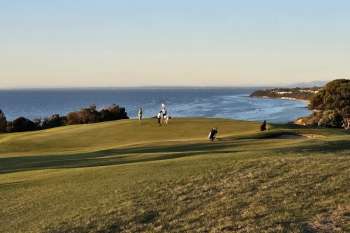Grassroots Issues - The War on Bugs
Do superintendents go too far to protect your course?
As golfers we see the small warning sign by the first tee, advising that ‘chemical spraying is in progress.’ Next is the maintenance crew dressed in space suits, and looking like they’ve just returned from a lunar landing as they spray mysterious substances over the holes you are about to play.
Such chemical treatments are adopted by superintendents to both control disease and weed, and also treat areas affected by unwanted insects and bugs. But as golfers playing on freshly sprayed turf, should we be concerned for our health and wellbeing when such programs are in place? To find out we asked leading Australian superintendents Cory Budden and John Geary, who each have very specific experience dealing with issues of disease and insect infestation. We also borrowed a couple of reassuring quotes from Russ Myers and Matt Shaffer, superintendents at revered clubs in America.
John Geary, Former Environmental Agronomist with the ‘Australian Golf Course Superintendent’s Association’ (AGCSA)
Possibly the greatest
challenge facing today’s turf manager is the ever-increasing expectation by
golfers and golf clubs to provide pristine playing conditions all year round.
From an agronomic perspective this places enormous pressure on the turf with
practices such as mowing of greens six-seven days a week, lower heights of cut,
less or no renovations undertaken (hollow tyning), etc becoming the norm.
Today’s golfer also expects to play on blemish free turf surfaces and the use
of pesticides is one of many tools used by Superintendent’s to help control
fungal pathogens, insects and unwanted weed species.
On a positive note, today’s turf manager is better educated and more
environmentally conscious than ever before. This can be highlighted when
looking at the works being undertaken by past recipients of the golf industry’s
‘Claude Crockford Environmental Award’, which recognises commitment to
environmental stewardship and sustainability within the Australian golf
industry.
Cory Budden, Superintendent Sandhurst Club
Here at Sandhurst Club we take great care to ensure none of our spraying of pesticides has any impact on our golfers. There are a lot of looks every time the sprayers head out of the shed (particularly on ladies day). With having 36 holes, I can schedule the majority of spray works on the course with least amount of play.
Unfortunately Pesticides are a necessary evil. Without their use turf quality would suffer greatly. I’m sure golfers much prefer playing off healthy grass as opposed to turf destroyed by grubs, disease or infested with weeds. Some of the new work with biological controls, such as beneficial fungi to naturally fight disease, looks very encouraging. That said, it would be a very brave Superintendent to rely entirely on biological controls and not chemical spraying!
Russ Myers, Superintendent Los Angeles Country Club, USA
‘Often the applicator is wearing a suit simply to avoid getting his clothes discoloured. As for chemicals, I’ll share what Michigan State biology professor Dr. Joseph Vargas said: The drugs we call medicines are really human pesticides. It doesn’t matter if a bacterium or fungus is attacking a human or a plant; if you’re going to control it, you have to use a chemical to kill it. His point is, if we called fungicides, herbicides and pesticides “golf-course medicines,” we’d look at them differently.’
Matt Shaffer, Superintendent Merion Golf Club, USA
Many times they’re spraying wetting agents, which are nothing more than highly refined soaps.
Darius Oliver
Back to NewsMore News
Report reveals golf's $3.3 billion contribution to Australia
AGIC report reveals total annual benefits to the Australian community, economy and environment from golf.
Cape Wickham Links – The Inside Design Story
Co-designer Darius Oliver reveals the truth behind the design of Australia’s premier modern golf course
Min Woo Lee signs up for Aussie PGA title defence
Reigning champion locks in the defence of his title at Royal Queensland Golf Club in November
Have your say on the future of Moore Park Golf
Golfers unite – another one of our cherished public access golf courses is under threat




